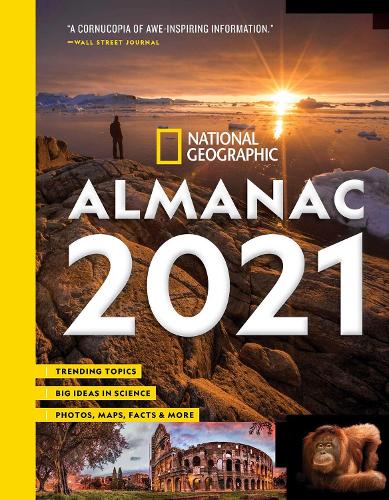
National Geographic Almanac 2021
(Paperback)
Publishing Details
National Geographic Almanac 2021
By (Author) National Geographic
National Geographic Society
National Geographic Society
29th October 2020
United States
Classifications
General
Non Fiction
Nature and the natural world: general interest
Yearbooks, annuals, almanacs
910
Physical Properties
Paperback
400
Width 181mm, Height 232mm
Description
A guide to the world like no other, this vivid and comprehensive book offers the best of National Geographic and more- science, nature, history, world cultures, geography, and the environment, illustrated with amazing photography, fascinating infographics, and maps created by expert cartographers. Highlights this year include a sneak preview of the James Webb telescope, due to launch in 2021; an in-depth look at the global factors influencing immigration around the world; a brand-new wildflower guide; a guided tour of the most interesting moons of our solar system; a beautiful infographic on how jellyfish eat; and a feature on lithium, the fascinating mineral central to the work of this year's Nobel prizewinner in chemistry.
Beginning with top trending topics of 2021, including a special focus on biodiversity, the book is divided into lively chapters including Exploration & Adventure, This Planet & Beyond, Life on Earth, and The Science of Us. Recurring features include highlights from NG explorers, favorite photos from National Geographic's celebrated Instagram account, and Quizmaster trivia questions for each chapter. Geniuses of past and present highlighted this year include Jane Goodall, Amelia Earhart, and acclaimed conservationist Kris Tompkins, who is dedicated to preserving most of Chile's Patagonia.
With new discoveries on every page, this cutting-edge book--called a "category buster" by Booklist--brings you, as Publishers Weekly puts it, "all the things that National Geographic does best.
Author Bio
One of the world's leading nonfiction publishers, NATIONAL GEOGRAPHIC has published more than 1,700 titles, featuring such categories as history, travel, nature, photography, space, science, health, biography, and memoir. A portion of its proceeds is used to fund exploration, conservation, and education through ongoing contributions to the work of the National Geographic Society.
